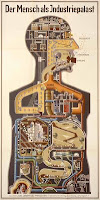Man's internal machinery
 Several years ago, I came across an interesting old illustration on the National Institute of Health (NIH) website. It shows the human body as a factory -- literally, as an "industrial palace." I saved the image because I liked it, and then I quickly forgot about it.
Several years ago, I came across an interesting old illustration on the National Institute of Health (NIH) website. It shows the human body as a factory -- literally, as an "industrial palace." I saved the image because I liked it, and then I quickly forgot about it. Tonight, I came across the "Industrial Palace" again, and looked at it a little differently, due to my recent (small) study of the modernistic architecture of the early and middle 20th century.
Here are the details of this piece of art, according to the NIH:
Der Mensch als Industriepalast (Man as Industrial Palace)by Fritz Kahn (1888-1968)Stuttgart, 1926. Chromolithograph. National Library of Medicine.Kahn’s modernist visualization of the digestive and respiratory system as "industrial palace," really a chemical plant, was conceived in a period when the German chemical industry was the world’s most advanced.
Source: Dreaming the Industrial Body
It seems that, in the 1920s and 1930s, people were extremely excited about machines. It was the Machine Age. The assembly line had been invented, enabling many people to own personal machines -- automobiles. High speed travel was possible via big ocean liners and streamlined trains. Electricity, produced by generators and turbines, was transforming everyday life. Mechanized factories were churning out many new, inexpensive consumer goods. Machines even made it possible for people to fly.
I've been reading that modernists thought of schools as machines for learning, houses as machines for living, and hospitals as machines for healing. Designed for speed and efficiency, the architecture sometimes seemed cold. Unnecessary frills were stripped away, and the design was streamlined just as a train or an airplane might have been. This was modern!
Given all that, it's not too surprising to see the human body portrayed as a factory, in a drawing from 1926. Fritz Kahn, a doctor, was just creating a bit of modernistic medical art.
2 comments:
I suppose the metaphor could be useful, but those little human workers in there are vaguely disturbing.
It would be a cool poster to hang up in an elementary school classroom while studying some system of internal organs.
Post a Comment